Blog
Electronic Article Surveillance (EAS): What It Is and How It Works

Electronic article surveillance (EAS) is a type of system used to prevent shoplifting. If you've ever been to a store and heard an alarm when somebody was exiting you've seen the EAS system in action. The system is designed to detect unpaid items in people's pockets or bags as they are leaving the store. It typically consists of two components: the EAS antennas and EAS tags or labels.
EAS antennas, sometimes called pedestals, are commonly installed at store entrances. EAS tags and labels, on the other hand, are attached to the merchandise to be protected. EAS antennas send and listen to signals at a specific frequency, usually within a range of six to eight feet. When an EAS tag or label passes between the antennas, it is detected and the store alarm is activated. To prevent unnecessary alarms, store cashiers remove or deactivate EAS tags and labels at the point of purchase.
Basic Types of Electronic Article Surveillance (EAS) Systems
EAS was invented in 1966 by an American inventor Arthur Minasy. Since then, the EAS technology has evolved, and different types of it have come and gone. The two most common ones that are still widely in use today are AM (acousto-magnetic) and RF (radio frequency) systems.
A deep technical discussion about the differences between the two systems is beyond the scope of this article, so we will just go over the basic differences that matter most to retailers. The AM systems work at the frequency of 58 kHz (kilohertz), while the RF systems work at the frequency of 8.2 MHz (megahertz). Visually they are very similar, and to an untrained eye they look the same.
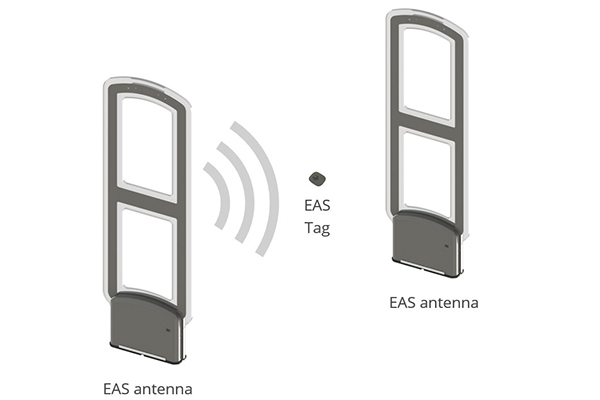 The most important thing to know is that EAS tags only work with the type of a system they are designed for. This means that AM systems can only detect AM tags, and RF systems can only detect RF tags. It doesn’t matter if the system, tags and labels in the store are from different manufacturers – it only matters that they work on the same frequency (AM or RF).
The most important thing to know is that EAS tags only work with the type of a system they are designed for. This means that AM systems can only detect AM tags, and RF systems can only detect RF tags. It doesn’t matter if the system, tags and labels in the store are from different manufacturers – it only matters that they work on the same frequency (AM or RF).
A retail chain will typically have either AM or RF technology in all its stores, and will seldom have both. This is done to simplify the operations and not accidentally mix up and send wrong tags to a store.
AM systems are very easy to install any use. They are reliable and resistant to radio or magnetic interference. They are popular among a variety of retailers, especially apparel stores. A wide variety of EAS tags exists that work with AM systems for a wide variety of merchandise. One drawback to AM systems is that paper-thin labels are not available for them. An AM label is a bit thicker and not particularly flexible, so it is unsuitable for food packaging and other merchandise where a simple label is needed.
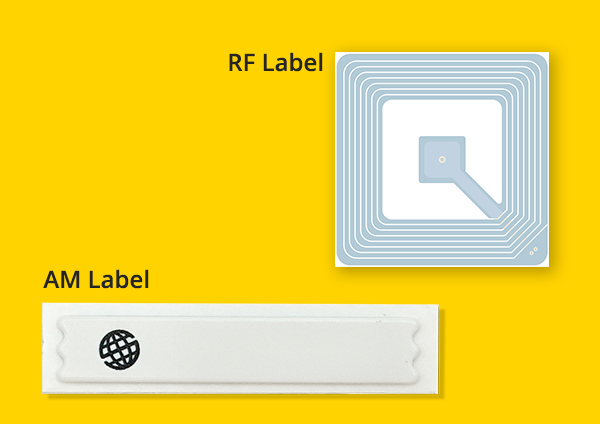 RF systems, on the other hand, are a bit more sensitive and require expert installation. If not properly set up (“tuned”) they can be susceptible to false alarms. However, it must be said that a well-built and well-tuned RF system is just as effective as an AM system. The biggest benefit of RF systems is that they work with very thin EAS labels, so they are a great choice for grocery stores, cosmetics stores, or other retailers that sell merchandise for which a plastic EAS tag would be too bulky.
RF systems, on the other hand, are a bit more sensitive and require expert installation. If not properly set up (“tuned”) they can be susceptible to false alarms. However, it must be said that a well-built and well-tuned RF system is just as effective as an AM system. The biggest benefit of RF systems is that they work with very thin EAS labels, so they are a great choice for grocery stores, cosmetics stores, or other retailers that sell merchandise for which a plastic EAS tag would be too bulky.
There is a third type of an EAS system that we did not previously mention. It’s called RFID (which stands for “radio frequency identification”). This is not technically an electronic article surveillance system, although it is sometimes used as one. The primary purpose (and biggest benefit) of an RFID system is to identify a specific product that passes by the antennas. For example, while AM and RF systems only detect that an EAS tag or label just passed through, an RFID system can detect that the tag or label is attached to Levi’s jeans, dark blue, size 34. In other words, an RFID tag or label carries some identifying information letting the system know what’s leaving the store. We will discuss RFID systems more in a future article.
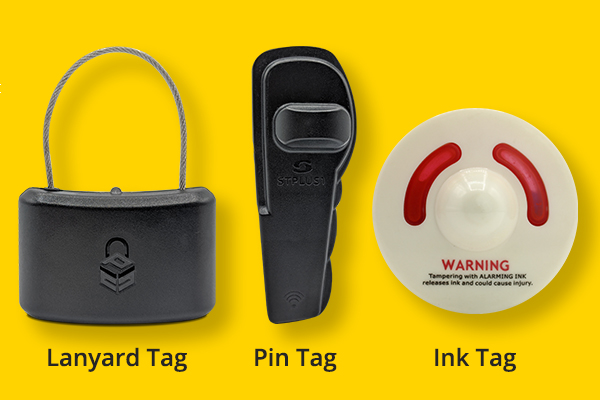 EAS Tags and Labels: Basic Types
EAS Tags and Labels: Basic Types
When we say “EAS tag,” we mean a small device made of plastic that’s attached to the merchandise being protected. When we say “EAS label,” we mean a paper sticker or a very thin strip of plastic with an EAS circuit hidden inside that’s affixed to merchandise like any label.
EAS tags come in different form factors. Some of the most common ones are shown in the picture on the left. Whether a particular tag is AM or RF is sometimes impossible to tell just by looking at it – they often look the same.
Feature-wise, there are several variants among tags. Some are simple, and only trigger the store alarm when passing between the EAS antennas at the door. Some are self-alarming, meaning that they can tell if someone is tampering with them or trying to remove them improperly. In that case, they sound their own alarm, powered by an internal battery. These self-alarming tags are usually used on higher-priced merchandise or on items especially susceptible to theft.
When it comes to labels, there is really only one form factor for AM systems – the thin “plasticky” strip you’ve probably seen affixed to the boxes of electronics. RF labels, on the other hand, can come in different sizes, shapes and colors, and they look like ordinary stickers. Sometimes the price sticker has a hidden RF circuit hidden beneath, and one would never know!
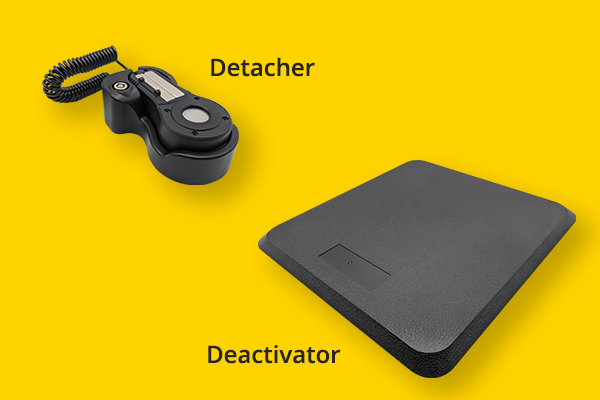 How EAS Tags and Labels are Removed or Deactivated
How EAS Tags and Labels are Removed or Deactivated
When an item is purchased, plastic EAS tags are removed by the cashiers with the help of a detacher typically installed at the register. The tags can be reused many times. The self-alarming ones (with internal batteries) usually have a lifespan of 2-3 years, while the simpler, non-alarming ones can last many years more, until they are physically damaged.
Labels, on the other hand, are not removed but deactivated. This is accomplished by a deactivator pad at the register – the cashier simply waves the item over the pad and the EAS label is deactivated. Sometimes the deactivator pad is built in with the price scanner, so one motion accomplishes two tasks – scans the price and deactivates the EAS label.
One Technology, Many Uses
There is a great variety of electronic article surveillance systems, tags and labels. For example, while the pedestal-style EAS systems are most common, there are also ones that are hidden in the floor by the store entrance, or installed on the ceiling, or even in the door frame itself.
EAS tags come in even more form factors – there are simple pin tags and lanyard tags used on apparel, handbags and accessories, but then there are many specialized types like the ones for golf clubs, liquor bottles, eyewear, boxed merchandise, shoes, waterproof items, etc.
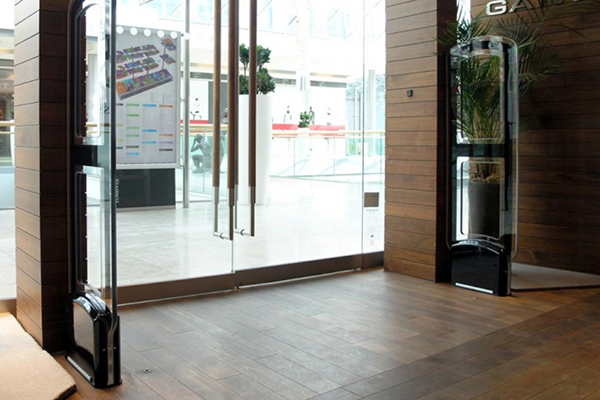 As technology continues to evolve, new form factors continue to appear, and existing ones continue to get improved. EAS systems can now also count the people entering and exiting the store, giving the retailers an insight into traffic patterns at various locations. Some can be remotely accessed for diagnostics and tuning purposes, reducing the need to send service people to the physical location.
As technology continues to evolve, new form factors continue to appear, and existing ones continue to get improved. EAS systems can now also count the people entering and exiting the store, giving the retailers an insight into traffic patterns at various locations. Some can be remotely accessed for diagnostics and tuning purposes, reducing the need to send service people to the physical location.
And tags evolve too, in order to deal with new strategies that shoplifters develop. Over time EAS tags have become more tamper-resistant, easier to detect, and some have even developed an ability to surprise shoplifters, like the ones with hidden ink that spills and ruins the garment if forcibly removed.
Electronic article surveillance is not new technology any more. But with constant improvements over many years it has proven itself as a reliable and resilient tool in the retailers’ arsenal for controlling theft. With never-ending innovation, one can be sure that EAS will continue to play an important role in the world of loss prevention for many years to come.